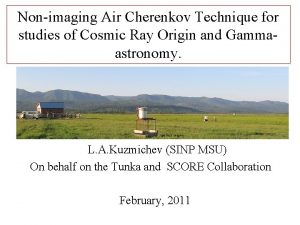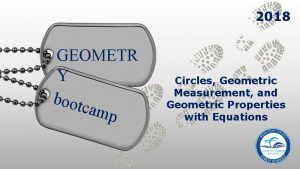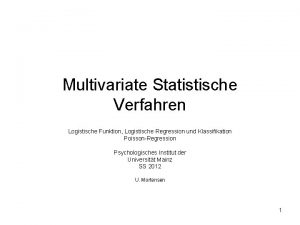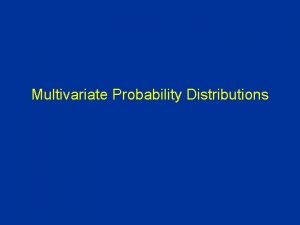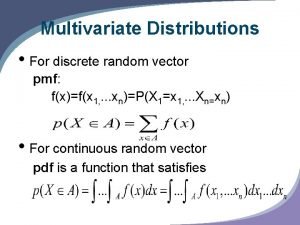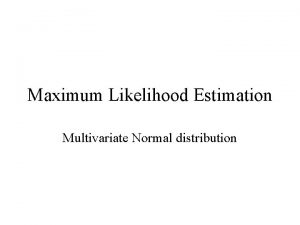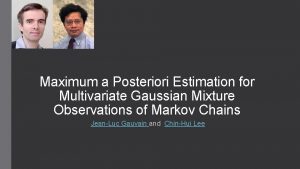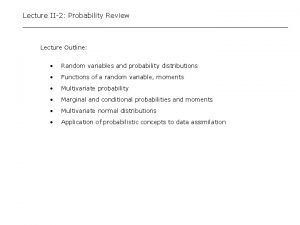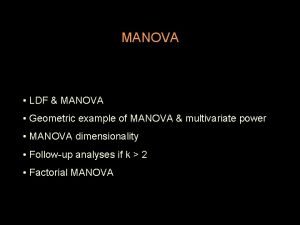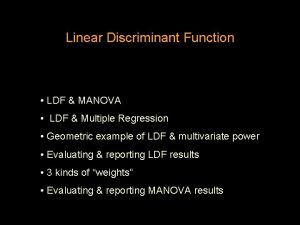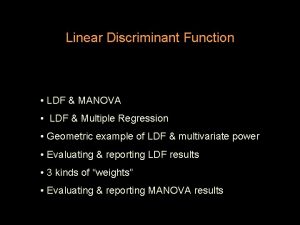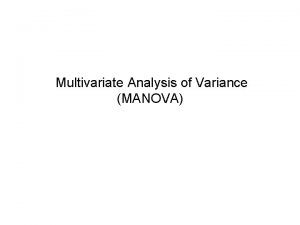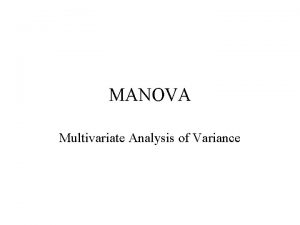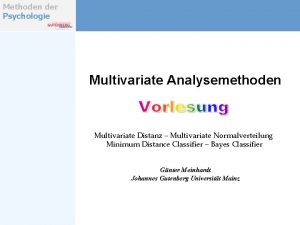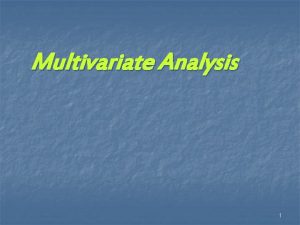MANOVA LDF MANOVA Geometric example of MANVOA multivariate











- Slides: 11

MANOVA • LDF & MANOVA • Geometric example of MANVOA & multivariate power • MANOVA dimensionality • Follow-up analyses if k > 2 • Factorial MANOVA

ldf & MANOVA 1 grouping variable and multiple “others” (quantitative or binary) Naming conventions : • LDF -- if the groups are “naturally occurring” • bio-taxonomy to diagnostic categories & measurement • grouping variable is called the “criterion” • others called the “discriminator” or “predictor” variables • MANOVA -- if the groups are the “result of IV manipulation” • multivariate assessment of agricultural “programs” • grouping variable is called the “IV” • others called the “DVs”

Ways of thinking about the “new variable” in MANOVA • (like regression) involves constructing a “new” quantitative variate from a weighted combination of quantitative, binary, or coded predictors, discriminators or DVs • The “new” variable is constructed so that when it is used as the DV in an ANOVA, the F-value will be as large as possible (simultaneously maximizing between groups variation and minimizing within-groups variation) • the “new” variable is called • MANOVA variate -- a “variate” is constructed from variables • linear discriminant function -- a linear function of the original variables constructed to maximally discriminate among the “groups” • canonical variate -- alludes to canonical correlation as the general model within which all corr and ANOVA models fit

How MANOVA works -- two groups and 2 vars V a r # 2 Var #1 Plot each participant’s position in this “ 2 -space”, keeping track of group membership. Mark each groups “centroid”

Look at the group difference on each variable, separately. V a r # 2 Var #1 The dash/dot lines show the mean difference on each variable -which are small relative to within-group differences, so small Fs

The MANOVA variate “positioned” to maximize resulting F V a r # 2 Var #1 In this way, two variables with non-significant ANOVA Fs can combine to produce a significant MANOVA F

Like ANOVA, ldf can be applied to two or more groups. • When we have multiple groups there may be an advantage to using multiple discriminant functions to maximally discriminate between the groups. • That is, we must decide whether the multiple groups “line up” on a single dimension (called a concentrated structure), or whether they are best described by their position in a multidimensional “space” (called a diffuse structure). Maximum # dimensions for a given analysis: the smaller of # groups - 1 # predictor variables e. g. , 4 groups with 6 predictor variables ? Max # ldfs = _____

“Anticipating” the number of dimensions (MANOVAs) By inspecting the “group profiles, ” (means of each group on each of the predictor variables) you can often anticipate whethere will be more than one ldf … • if the groups have similar patterns of differences (similar profiles) for each predictor variable (for which there are differences), then you would expect a single discriminant function. • If the groups have different profiles for different predictor variables, then you would expect more than one ldf Group 7 Var 1 Var 2 Var 3 Var 4 Group Var 1 Var 2 Var 3 Var 4 1 10 12 6 8 1 10 12 6 14 2 18 12 10 2 2 18 6 6 14 3 18 12 10 2 3 18 0 + - Concentrated + Diffuse 1 st + 2 nd 0 0 6 0 - 2 0 -

Determining the number of dimensions (variates) Like other “determinations”, there is a significance test involved • Each variate is tested as to whether it “contributes to the model” using one of the available F-tests of the -value. • The first variate will always account for the most between-group variation (have the largest F and Rc) -- subsequent variates are “orthogonal” (providing independent information), and will account for successively less between group variation. • If there is a single variate, then the model is said to have a concentrated structure • if there are 2 or more variates then the model has a diffuse structure • the distinction between a concentrated and a diffuse structure is considered the “fundamental multivariate question” in a multiple group analysis.

There are two major types of follow-ups when k > 2 • Univariate follow-ups -- abandoning the multivariate analysis, simply describe the results of the ANOVA (with pairwise comparisons) for each of the predictors (DVs) • MANOVA variate follow-ups -- use the ldf(s) as DVs in ANOVA (with pairwise comparisons) to explicate what which ldfs discriminate between what groups • this nicely augments the spatial & re-classification depictions • if you have a concentrated structure, it tells you exactly what groups can be significantly discriminated • if you have a diffuse structure, it tells you whether the second variate provides discriminatory power the 1 st doesn’t

Factorial MANOVA A factorial MANOVA is applied with you have. . . • a factorial design • multiple DVs A factorial MANOVA analysis is (essentially) a separate MANOVA performed for each of the factorial effects, in a 2 -way factorial. . . • Interaction effect • one main effect • other main effect It is likely that the MANOVA variates for the effects will not be the same. Said differently, different MANOVA main and interaction effects are likely to be produced by different DV combinations & weightings. So, each variate for each effect must be carefully examined and interpreted!
